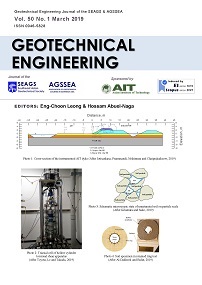Backpressure Saturation Effects on the Mechanical Behaviour of a Quasi-Saturated Compacted Residual Soil
Main Article Content
Abstract
The use of saturation methods in triaxial tests is a common practice to obtain the strength parameters of the soil in effective terms. However, these methods may influence the results obtained in the laboratory negatively. For instance, undesirable volumetric variations in the sample may be created depending on the saturation stages applied to the samples. Furthermore, these methods commonly require large backpressure values to saturate samples even if their saturation corresponds to the “quasi-saturated state”. This quasi-saturated state (related to saturation values above 90%) is commonly found in the engineering practice for fills of embankment compacted above the optimum water content. At this state, the soil is expected to behave as a saturated soil and the suction of the soil tends to be zero. This paper studies the effect of two saturation processes in a residual soil from São Paulo, Brazil, compacted in the quasi-saturated state. CIU triaxial tests were performed with fully saturated and quasi-saturated samples. Both processes lead the samples to different wetting paths and volumetric changes that, as a result, influenced the pore-water pressure development and the effective strength parameters.
Article Details

This work is licensed under a Creative Commons Attribution-NonCommercial-NoDerivatives 4.0 International License.
Copyright © 2019 Association of Geotechnical Societies in Southeast Asia (AGSSEA) - Southeast Asian Geotechnical Society (SEAGS).


